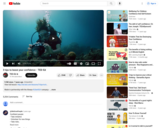
View full lesson: http://ed.ted.com/lessons/3-tips-to-boost-your-confidence-ted-edMade in partnership with the Always #LikeAGirl campaign.When faced with a b...
- Subject:
- Education
- Health Education
- Material Type:
- Other
- Date Added:
- 10/04/2023

View full lesson: http://ed.ted.com/lessons/3-tips-to-boost-your-confidence-ted-edMade in partnership with the Always #LikeAGirl campaign.When faced with a b...
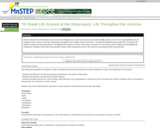
This classroom activity will show students that there is a lot we don't know about science, for example life throughout the universe. It will hopefully encourage students to question what we know and don't know, and exploration and study of the unknown.
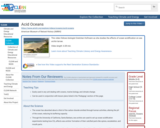
This video follows biologist Gretchen Hofmann as she studies the effects of ocean acidification on sea urchin larvae.
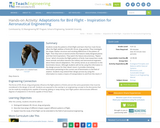
This activity first asks the students to study the patterns of bird flight and understand that four main forces affect the flight abilities of a bird. They will study the shape, feather structure, and resulting differences in the pattern of flight. They will then look at several articles that feature newly designed planes and the birds that they are modeled after. The final component of this activity is to watch the Nature documentary, "Raptor Force" which chronicles the flight patterns of birds, how researchers study these animals, and what interests our military and aeronautical engineers about these natural adaptations. This activity serves as an extension to the biomimetics lesson. Although students will not be using this information in the design process for their desert resort, it provides interesting information pertaining to the current use of biomimetics in the field of aviation. Students may extend their design process by using this information to create a means of transportation to and from the resort if they chose to.

Spreadsheets across the Curriculum Module. Students build a spreadsheet to calculate proper medicine dosages using the metric system.
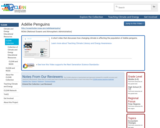
A short video that discusses how changing climate is affecting the population of AdÃlie penguins.
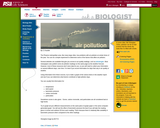
The Phoenix metropolitan area, like many large cities, has problems with air pollution at certain times of the year. You can do a simple experiment to determine some of the factors that affect air pollution.

This class analyzes complex biological processes from the molecular, cellular, extracellular, and organ levels of hierarchy. Emphasis is placed on the basic biochemical and biophysical principles that govern these processes. Examples of processes to be studied include chemotaxis, the fixation of nitrogen into organic biological molecules, growth factor and hormone mediated signaling cascades, and signaling cascades leading to cell death in response to DNA damage. In each case, the availability of a resource, or the presence of a stimulus, results in some biochemical pathways being turned on while others are turned off. The course examines the dynamic aspects of these processes and details how biochemical mechanistic themes impinge on molecular/cellular/tissue/organ-level functions. Chemical and quantitative views of the interplay of multiple pathways as biological networks are emphasized. Student work will culminate in the preparation of a unique grant application in an area of biological networks.
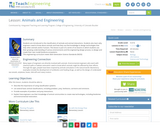
Students are introduced to the classification of animals and animal interactions. Students also learn why engineers need to know about animals and how they use that knowledge to design technologies that help other animals and/or humans. This lesson is part of a series of six lessons in which students use their growing understanding of various environments and the engineering design process, to design and create their own model biodome ecosystems.

Farming ants might sound like a crazy thing to do unless you might like to eat chocolate covered ants. It turns out we can learn a lot from ants and the best way is to build your own ant farm.
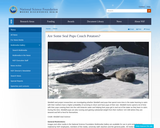
Weddell seal project researchers are investigating whether Weddell seal pups that spend more time in the water learning to swim with their mothers have a higher probability of surviving to return and have pups of their own. Weddell moms spend a lot of time with their pups coaxing them into the cold Antarctic water and helping their pups get in and out of the water as they learn to swim. During this time, Weddell pups are also nursing and gaining substantial weight from their mothers' rich milk before they are weaned and left to fend for themselves.
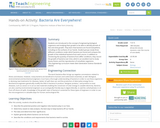
Students are introduced to the concept of engineering biological organisms and studying their growth to be able to identify periods of fast and slow growth. They learn that bacteria are found everywhere, including on the surfaces of our hands. Student groups study three different conditions under which bacteria are found and compare the growth of the individual bacteria from each source. In addition to monitoring the quantity of bacteria from differ conditions, they record the growth of bacteria over time, which is an excellent tool to study binary fission and the reproduction of unicellular organisms.

In this inquiry activity, students generate investigable questions to explore the link between hygiene/cleanliness and bacteria growth/population. The students will present their conclusions, and video clips containing additional information will be discussed.
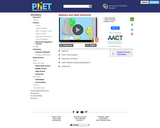
Students explore static electricity by rubbing a simulated balloon on a sweater. As they view the charges in the sweater, balloon, and adjacent wall, they gain an understanding of charge transfer. This item is part of a larger collection of simulations developed by the Physics Education Technology project (PhET). The simulations are animated, interactive, and game-like environments.

Why does a balloon stick to your sweater? Rub a balloon on a sweater, then let go of the balloon and it flies over and sticks to the sweater. View the charges in the sweater, balloons, and the wall.
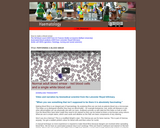
Introduction to haematology including link to OER on blood cell types, and how to perform blood counts on an automated analysis system. Resources also include a short video on how to perform a blood smear for histological staining.

This interactive shows the extent of the killing of lodgepole pine trees in western Canada. The spread of pine beetle throughout British Columbia has devastated the lodgepole pine forests there. This animation shows the spread of the beetle and the increasing numbers of trees affected from 1999-2008 and predicts the spread up until 2015.

This is an activity that involves students modeling the behavior and competition that Charles Darwin's finches would have gone through as they competed for food and space on the Galapagos Islands. Some will survive. Some won't.

Learners research the effects of melting sea ice in the Bering Sea Ecosystem. They create research proposals to earn a place on the scientific research vessel Healy and present their findings and proposals to a Research Board committee.
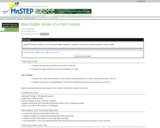
This activity is designed to help students understand the structures and functions of the cell by building a model.